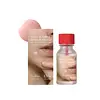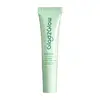What's inside
What's inside
 Key Ingredients
Key Ingredients

 Benefits
Benefits

 Concerns
Concerns

 Ingredients Side-by-side
Ingredients Side-by-side

Water
Skin ConditioningAlcohol
AntimicrobialCalamine
AbsorbentGlycerin
HumectantTitanium Dioxide
Cosmetic ColorantButylene Glycol
HumectantSalicylic Acid
MaskingPanthenol
Skin ConditioningDimethyl Sulfone
SolventCeramide NP
Skin ConditioningGlycolic Acid
BufferingCentella Asiatica Extract
CleansingTartaric Acid
BufferingMalic Acid
Buffering1,2-Hexanediol
Skin ConditioningCamellia Sinensis Leaf Extract
AntimicrobialLactic Acid
BufferingChamaecyparis Obtusa Leaf Extract
Skin ConditioningUlmus Davidiana Root Extract
Skin ConditioningPueraria Lobata Root Extract
HumectantPinus Palustris Leaf Extract
TonicOenothera Biennis Flower Extract
AstringentWater, Alcohol, Calamine, Glycerin, Titanium Dioxide, Butylene Glycol, Salicylic Acid, Panthenol, Dimethyl Sulfone, Ceramide NP, Glycolic Acid, Centella Asiatica Extract, Tartaric Acid, Malic Acid, 1,2-Hexanediol, Camellia Sinensis Leaf Extract, Lactic Acid, Chamaecyparis Obtusa Leaf Extract, Ulmus Davidiana Root Extract, Pueraria Lobata Root Extract, Pinus Palustris Leaf Extract, Oenothera Biennis Flower Extract
Water
Skin ConditioningButylene Glycol
HumectantSalvia Miltiorrhiza Root Extract
Skin ConditioningCentella Asiatica Extract
CleansingSpiraea Ulmaria Extract
AstringentSalicylic Acid
MaskingNiacinamide
SmoothingAmylopectin
Glycerin
HumectantXanthan Gum
EmulsifyingCyclodextrin
AbsorbentPlatonin
Skin ConditioningCeramide 3
Skin ConditioningCeramide 6 Ii
Skin ConditioningCeramide 1
Skin ConditioningPortulaca Oleracea Extract
Skin ConditioningPanthenol
Skin ConditioningSodium Hyaluronate
HumectantBeta-Glucan
Skin ConditioningLactobacillus/Soymilk Ferment Filtrate
Skin ConditioningPentylene Glycol
Skin ConditioningHydroxyphenyl Propamidobenzoic Acid
Skin ConditioningJuniperus Communis Fruit Extract
PerfumingMorus Alba Root Extract
BleachingPerilla Ocymoides Leaf Extract
TonicHemerocallis Fulva Flower Extract
Skin ConditioningMaltodextrin
AbsorbentCalcium Pantothenate
Urea
BufferingCaprylyl Glycol
EmollientEthylhexylglycerin
Skin ConditioningPapain
Skin ConditioningSodium Citrate
BufferingMagnesium Chloride
Magnesium Lactate
BufferingPotassium Lactate
BufferingSerine
MaskingAlanine
MaskingProline
Skin ConditioningGlycolic Acid
BufferingCaprylhydroxamic Acid
O-Cymen-5-Ol
AntimicrobialCeramide AP
Skin Conditioning1,2-Hexanediol
Skin ConditioningAcrylates/C10-30 Alkyl Acrylate Crosspolymer
Emulsion StabilisingZinc PCA
HumectantAllantoin
Skin ConditioningDipotassium Glycyrrhizate
HumectantPhytosphingosine
Skin ConditioningCholesterol
EmollientSodium Lauroyl Lactylate
EmulsifyingCarbomer
Emulsion StabilisingWater, Butylene Glycol, Salvia Miltiorrhiza Root Extract, Centella Asiatica Extract, Spiraea Ulmaria Extract, Salicylic Acid, Niacinamide, Amylopectin, Glycerin, Xanthan Gum, Cyclodextrin, Platonin, Ceramide 3, Ceramide 6 Ii, Ceramide 1, Portulaca Oleracea Extract, Panthenol, Sodium Hyaluronate, Beta-Glucan, Lactobacillus/Soymilk Ferment Filtrate, Pentylene Glycol, Hydroxyphenyl Propamidobenzoic Acid, Juniperus Communis Fruit Extract, Morus Alba Root Extract, Perilla Ocymoides Leaf Extract, Hemerocallis Fulva Flower Extract, Maltodextrin, Calcium Pantothenate, Urea, Caprylyl Glycol, Ethylhexylglycerin, Papain, Sodium Citrate, Magnesium Chloride, Magnesium Lactate, Potassium Lactate, Serine, Alanine, Proline, Glycolic Acid, Caprylhydroxamic Acid, O-Cymen-5-Ol, Ceramide AP, 1,2-Hexanediol, Acrylates/C10-30 Alkyl Acrylate Crosspolymer, Zinc PCA, Allantoin, Dipotassium Glycyrrhizate, Phytosphingosine, Cholesterol, Sodium Lauroyl Lactylate, Carbomer
Ingredients Explained
These ingredients are found in both products.
Ingredients higher up in an ingredient list are typically present in a larger amount.
1,2-Hexanediol is a synthetic liquid and another multi-functional powerhouse.
It is a:
- Humectant, drawing moisture into the skin
- Emollient, helping to soften skin
- Solvent, dispersing and stabilizing formulas
- Preservative booster, enhancing the antimicrobial activity of other preservatives
Butylene Glycol (or BG) is used within cosmetic products for a few different reasons:
Overall, Butylene Glycol is a safe and well-rounded ingredient that works well with other ingredients.
Though this ingredient works well with most skin types, some people with sensitive skin may experience a reaction such as allergic rashes, closed comedones, or itchiness.
Learn more about Butylene GlycolCentella Asiatica Extract (Centella) is derived from an herb native to Southeast Asia. It is famous for its anti-inflammatory and soothing properties.
Centella is rich in antioxidants and amino acids, such as Madecassic Acid and Asiaticoside.
Studies show the compounds in centella help with:
The combination of all these properties makes centella effective at soothing, hydrating, and protecting the skin.
Other great components of centella include Vitamin A, vitamin C, several B vitamins, and Asiatic Acid.
Fun fact: Centella has been used as a medicine and in food for many centuries. As a medicine, it is used to treat burns, scratches, and wounds.
Learn more about Centella Asiatica ExtractGlycerin is already naturally found in your skin. It helps moisturize and protect your skin.
A study from 2016 found glycerin to be more effective as a humectant than AHAs and hyaluronic acid.
As a humectant, it helps the skin stay hydrated by pulling moisture to your skin. The low molecular weight of glycerin allows it to pull moisture into the deeper layers of your skin.
Hydrated skin improves your skin barrier; Your skin barrier helps protect against irritants and bacteria.
Glycerin has also been found to have antimicrobial and antiviral properties. Due to these properties, glycerin is often used in wound and burn treatments.
In cosmetics, glycerin is usually derived from plants such as soybean or palm. However, it can also be sourced from animals, such as tallow or animal fat.
This ingredient is organic, colorless, odorless, and non-toxic.
Glycerin is the name for this ingredient in American English. British English uses Glycerol/Glycerine.
Learn more about GlycerinGlycolic Acid is arguably the most famous alpha hydroxy acid (AHA) with tons of research backing its benefits.
It is found naturally in sugar cane but the form used in skincare is usually synthetic for purity and stability.
Glycolic acid removes the top layer of dead skin cells to allow newer and fresher ones to emerge.
AHAs work by breaking down the structural “glue” that holds old skin cells in place. When that buildup is gone, your skin can renew itself more efficiently.
Research also shows glycolic acid stimulates collagen production, helping to firm and thicken the skin over time. This is one of its biggest advantages over other AHAs.
Overall, glycolic acid helps with:
Fun fact: Glycolic acid boosts skin hydration by helping it produce molecules that increase hyaluronic acid naturally.
To work best, glycolic acid products should have a pH between 3-4 (that’s where exfoliation is most effective but still gentle on skin).
The pH and concentration of a product are key to its effectiveness:
It is normal to feel a slight stinging sensation when using glycolic acid. This usually fades as your skin adjusts.
Because glycolic acid has the smallest molecular size in the AHA family, it can penetrate deeper, which enhances its effectiveness but also makes it more likely to irritate sensitive skin.
If your skin is very sensitive or prone to rosacea, glycolic acid may be too strong; in that case, try milder options like lactic acid or a PHA instead.
Recent studies suggest glycolic acid might even help protect against UV damage. But don’t skip sunscreen! Freshly exfoliated skin is more sensitive to the sun.
Glycolic acid is a skincare superstar. It smooths, brightens, hydrates, and firms the skin. Unless you’re highly sensitive, it’s well worth adding to your routine.
Read more about some other popular AHA's here:
Learn more about Glycolic AcidPanthenol is a common ingredient that helps hydrate and soothe the skin. It is found naturally in our skin and hair.
There are two forms of panthenol: D and L.
D-panthenol is also known as dexpanthenol. Most cosmetics use dexpanthenol or a mixture of D and L-panthenol.
Panthenol is famous due to its ability to go deeper into the skin's layers. Using this ingredient has numerous pros (and no cons):
Like hyaluronic acid, panthenol is a humectant. Humectants are able to bind and hold large amounts of water to keep skin hydrated.
This ingredient works well for wound healing. It works by increasing tissue in the wound and helps close open wounds.
Once oxidized, panthenol converts to pantothenic acid. Panthothenic acid is found in all living cells.
This ingredient is also referred to as pro-vitamin B5.
Learn more about PanthenolSalicylic Acid (also known as beta hydroxy acid or BHA) is a well-known ingredient for treating skin that struggles with acne and clogged pores. It exfoliates both the skin's surface and deep within the pores to help clear out buildup, control oil, and reduce inflammation.
Unlike AHAs (alpha hydroxy acids), salicylic acid is oil-soluble. This allows it to penetrate into pores which makes it especially effective for treating blackheads and preventing future breakouts.
Salicylic acid is also known for its soothing properties. It has a similar structure to aspirin and can calm inflamed or irritated skin, making it a good option for acne-prone skin that is also sensitive.
Concentrations of 0.5-2% are recognized by the U.S. FDA as an over-the-counter topical acne product.
It can cause irritation and/or dryness if one's skin already has a compromised moisture barrier, so it's best to focus on repairing that before introducing this ingredient into your routine.
While salicylic acid does not increase sun sensitivity, it’s still important to wear sunscreen daily to protect your skin.
If you are looking for the ingredient called BHA or Butylated Hydroxyanisole, click here.
Learn more about Salicylic AcidWater. It's the most common cosmetic ingredient of all. You'll usually see it at the top of ingredient lists, meaning that it makes up the largest part of the product.
So why is it so popular? Water most often acts as a solvent - this means that it helps dissolve other ingredients into the formulation.
You'll also recognize water as that liquid we all need to stay alive. If you see this, drink a glass of water. Stay hydrated!
Learn more about Water